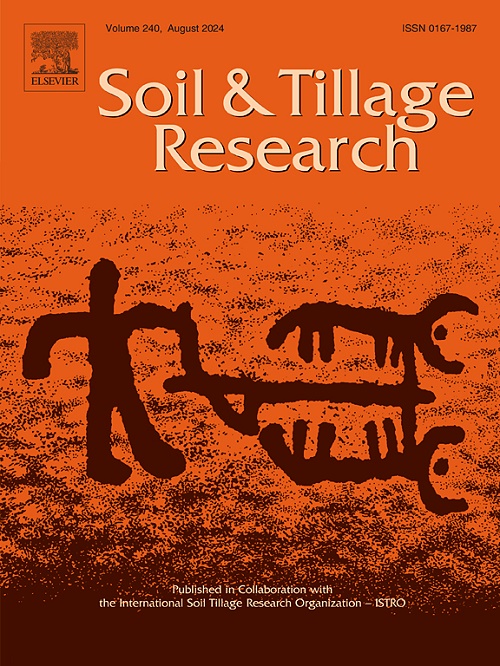活化水灌溉技术的应用:提高南疆沙区土壤肥力和作物适应性的可持续途径
IF 6.1
1区 农林科学
Q1 SOIL SCIENCE
引用次数: 0
摘要
活性水处理技术作为干旱沙质土壤的绿色灌溉策略,在提高南疆沙漠绿洲生态系统土壤肥力和作物生产力方面具有重要潜力。本研究通过为期两年的田间试验,系统评价了常规非活性水(CK)、磁电活性水(MI)、微纳氧化水(IO)和磁电氧化水(MO) 4种灌溉处理的影响。研究了不同施氮量对苹果园根区土壤水分分布格局、养分有效性和转化效率、生理生长指标和产水协同效应的影响。结果表明,活化水灌溉促进了土壤养分的吸收和转化,提高了土壤肥力,土壤质量指数(SQI)提高了10.88 % ~ 32.59 %。在南疆土壤盐渍化和干旱缺水气候条件下,活化水灌溉增强了土壤保水能力,优化了土壤水分分布,提高了土壤水分有效性。此外,活化水灌溉有效提高了苹果树的抗旱性,CAT、POD和SOD活性提高了10 %以上,MDA降低了10.73 %。苹果产量提高12.11 % ~ 35.48 %,水分利用效率提高10.48 % ~ 30.19 %。在心肌梗死和心肌梗死之间观察到协同效应。建立了新疆沙漠绿洲农田科学灌溉调度和干旱地区土壤盐渍化缺水作物可持续集约化综合水激活框架。本文章由计算机程序翻译,如有差异,请以英文原文为准。
Application of activated water irrigation technology: A sustainable way to improve soil fertility and crop adaptability in the sandy area of southern Xinjiang
Activated water treatment technology, emerging as a green irrigation strategy for arid sandy soils, demonstrates critical potential in enhancing soil fertility and crop productivity in southern Xinjiang's desert-oasis ecosystems. This study conducted a two-year field experiment to systematically evaluate the impacts of four irrigation treatments: conventional non-activated water (CK), magnetoelectric activated water (MI), micro-nano oxygenated water (IO), and magnetoelectric-oxygenated water (MO). The investigation focused on their effects on root-zone soil moisture distribution patterns, nutrient availability and transformation efficiency, physiological growth indicator, and yield-water use synergies in apple orchards. The results indicate that activated water irrigation promotes soil nutrient absorption and conversion, improving soil fertility, with the soil quality index (SQI) increasing by 10.88 %–32.59 %. Under the conditions of soil salinization and the arid, water-scarce climate of southern Xinjiang, activated water irrigation enhances soil water retention, optimizes soil moisture distribution, and increases the effectiveness of soil moisture. Additionally, activated water irrigation effectively improves the drought resistance of apple trees, with CAT, POD, and SOD activities increasing by more than 10 %, and MDA reducing by up to 10.73 %. Apple yield increased by 12.11 %–35.48 %, and water use efficiency improved by 10.48 %–30.19 %. A synergistic effect was observed between MI and IO. This work establishes an integrated water activation framework for scientific irrigation scheduling in Xinjiang's desert-oasis farmlands and sustainable crop intensification in arid regions facing soil salinization and water scarcity.
求助全文
通过发布文献求助,成功后即可免费获取论文全文。
去求助
来源期刊

Soil & Tillage Research
农林科学-土壤科学
CiteScore
13.00
自引率
6.20%
发文量
266
审稿时长
5 months
期刊介绍:
Soil & Tillage Research examines the physical, chemical and biological changes in the soil caused by tillage and field traffic. Manuscripts will be considered on aspects of soil science, physics, technology, mechanization and applied engineering for a sustainable balance among productivity, environmental quality and profitability. The following are examples of suitable topics within the scope of the journal of Soil and Tillage Research:
The agricultural and biosystems engineering associated with tillage (including no-tillage, reduced-tillage and direct drilling), irrigation and drainage, crops and crop rotations, fertilization, rehabilitation of mine spoils and processes used to modify soils. Soil change effects on establishment and yield of crops, growth of plants and roots, structure and erosion of soil, cycling of carbon and nutrients, greenhouse gas emissions, leaching, runoff and other processes that affect environmental quality. Characterization or modeling of tillage and field traffic responses, soil, climate, or topographic effects, soil deformation processes, tillage tools, traction devices, energy requirements, economics, surface and subsurface water quality effects, tillage effects on weed, pest and disease control, and their interactions.
 求助内容:
求助内容: 应助结果提醒方式:
应助结果提醒方式:


